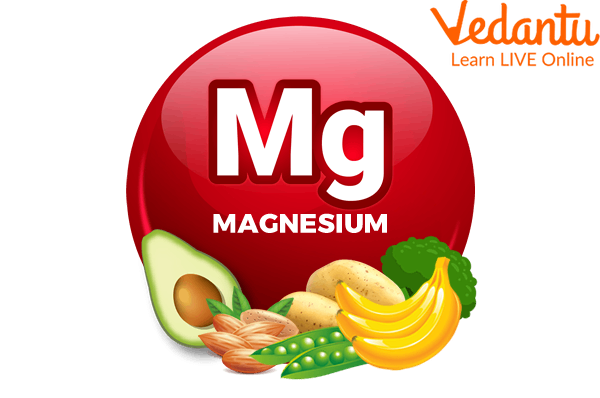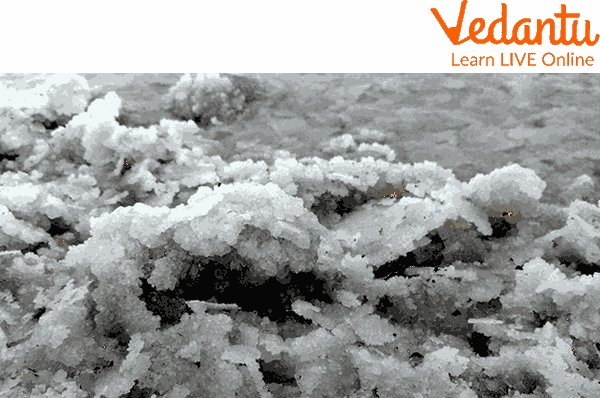




Why Magnesium Matters: Surprising Facts & Real-Life Examples
Kids, did you know that our periodic table contains 118 named elements? The periodic table is an arrangement of different elements in rows and columns. In the periodic table, gases are arranged in one column, whereas metals are placed in another column.
Magnesium is one of the most abundant elements in the periodic table. It is an alkaline metal and is found in group 2 of the periodic table. Not only in free form, but magnesium is also found in the human body. It is an essential component of plant and human bodies.

Magnesium Element
What is Magnesium?
The chemical element magnesium has the symbol Mg and the atomic number 12. Magnesium was first isolated by Sir Humphry Davy in 1808 and named 'magnum.' Antoine Bussy, in 1831, first prepared magnesium inconsistent form. Magnesium comes in the category of alkaline earth metal, and it is not present in free pure form, and its compounds are found in large deposits such as dolomite, magnesite, and other minerals.
Magnesium is the 8th most abundant element in the earth's crust, making up 13 per cent of our planet's mass. Magnesium is the most common element in the Earth as a whole, after iron, oxygen, and silicon. The weight of magnesium metal is light, but it is a strong, silvery-white metal. Magnesium tarnishes when exposed to air.
Magnesium is a very useful metal in industrial use, with a melting point of 1,994° Fahrenheit and a boiling point of 1,202° Fahrenheit. Magnesium is highly flammable in its powdered form and burns with a brilliant white flame. But it becomes challenging to ignite this metal as a large mass.

Magnesium
Uses of Magnesium
Uses of Magnesium include the following
Magnesium is found both outside and inside of humans. Magnesium has many beneficial uses, either as an element or a compound.
Magnesium sulphate is a salt consisting of magnesium and sulphate ions. It has a chemical formula, MgSO4. Magnesium sulphate is a white crystalline solid and is soluble in water. Magnesium sulphate is used to treat low amounts of magnesium in the blood.
Magnesium-rich foods include seeds, green leafy vegetables, whole grains, nuts, bananas, kiwi fruit, papayas, and wheat.
Magnesium Hydroxide is another compound of magnesium. The formula of magnesium hydroxide is Mg(OH)2, also called 'milk of magnesia.'
Magnesium Rich Foods
Magnesium is a mineral that is vital to the function of your body. It is involved in hundreds of biochemical reactions in the body and helps you to relax and sleep better. This makes magnesium even more important for people with anxiety who might be experiencing fatigue or sleep issues. Magnesium also has long-term health benefits – it can reduce inflammation, prevent muscle cramps, protect against certain types of cancer, and help regulate blood sugar levels.
Interesting Facts Of Magnesium
Let's learn some interesting facts about Magnesium
Magnesium was discovered by Joseph Black in the year 1775. Magnesium is derived from a Greek word called 'Magnesia,' which is also a place in Greek.
There are three stable isotopes of magnesium: Magnesium-24 found at 79%, Magnesium 25 at 10%, and Magnesium 26 at 11%. They all have a common atomic number but have different atomic masses.
Magnesium ions are found at the centre of the chlorophyll, the green photosynthetic pigment in plants. In 1915, Richard Willstatter was awarded the Nobel Prize for this discovery.
Magnesium is very necessary for many biochemical reactions that happen in our bodies. An average person requires about 250 to 350 mg of magnesium daily for a healthy body.
Our bones constitute about 60% of magnesium, and our muscles are composed of 39% of magnesium.
Once ignited, magnesium is extremely difficult to extinguish. Attempting to put out the fire using water produces hydrogen, and it burns more violently and fiercely.
Magnesium also burns in pure nitrogen and carbon dioxide, so a fire extinguisher with carbon dioxide will enhance the flames.
The most effective way to stop magnesium from burning is using a dry chemical fire extinguisher or just simply covering it with sand.
Magnesium ribbon is a thin strip of magnesium metal. The burning of the magnesium ribbon symbolizes a chemical change. Magnesium ribbon burns with a bright dazzling light producing white dense fumes. On cooling, this white powder turns into magnesium oxide.
Summary
In this article, we learned that magnesium is an element found in our nature. In the article above, we also learned about magnesium-rich foods, magnesium sulphate, the formula of magnesium hydroxide, magnesium ribbon, and some interesting facts about magnesium. The compounds of magnesium are very useful to humans in many ways. Magnesium oxide, MgO, is used in the agricultural, chemical, construction, and manufacturing industries.
When burnt, magnesium produces a quick and bright lightening flame and is used in pyrotechnics, flashlight photography, and flares. Magnesium is very light in its elemental form but is a very strong metal.
FAQs on Interesting Facts About Magnesium
1. What are some important uses of magnesium in everyday life and industry?
Magnesium is a versatile metal known for being extremely lightweight and strong. Its main uses include:
- Alloys: It is mixed with other metals to create strong, lightweight alloys used in car seats, luggage, laptops, and aircraft parts. Speciality car wheels are often called 'mag wheels' for this reason.
- Flares and Fireworks: Magnesium ignites easily in the air and burns with a brilliant white light, making it perfect for flares, fireworks, and sparklers.
- Industrial Processes: It is used to remove sulfur from molten iron and steel during production.
2. Which common foods are good sources of magnesium?
Magnesium is an essential mineral for our health. You can find it in a variety of foods, including:
- Leafy Green Vegetables: Spinach is an excellent source.
- Nuts and Seeds: Almonds, cashews, and pumpkin seeds are rich in magnesium.
- Legumes: Black beans, lentils, and chickpeas.
- Whole Grains: Brown rice and whole wheat bread.
- Dark Chocolate: A tasty source of magnesium.
3. What health problems can arise from a magnesium deficiency?
Not getting enough magnesium over a long period can lead to several health issues. A deficiency can contribute to problems like high blood pressure, an increased risk of heart disease, type 2 diabetes, and osteoporosis, particularly in women. It is vital for muscle and nerve function.
4. Who is credited with the discovery of magnesium?
Magnesium as an element was first isolated by the chemist Sir Humphry Davy in England in 1808. He used a process called electrolysis on a mixture of magnesia (magnesium oxide) and mercuric oxide.
5. Which country is the largest producer of magnesium in the world?
China is the world's dominant producer of magnesium. On average, it single-handedly supplies about 80% of the total magnesium used globally.
6. Why does magnesium burn with such a dazzlingly bright white light?
Magnesium burns with a brilliant light because of a highly exothermic reaction with oxygen in the air. When ignited, it rapidly oxidises to form magnesium oxide (MgO), releasing a massive amount of energy in the form of both heat and intense light. This property makes it ideal for emergency flares and pyrotechnics.
7. What makes magnesium a unique member of the alkaline earth metals family?
While magnesium shares properties with other alkaline earth metals like calcium and beryllium, it stands out primarily because of its remarkably low density. It is the lightest of all structural metals, being about two-thirds the density of aluminium. This unique combination of being lightweight yet strong (when alloyed) makes it invaluable for applications where reducing weight is critical, such as in the aerospace and automotive industries.
8. How does magnesium's role in plants compare to its role in the human body?
Magnesium plays a critical, yet different, role in plants and humans. In plants, a magnesium atom sits at the core of every chlorophyll molecule, making it absolutely essential for photosynthesis—the process of converting sunlight into energy. In the human body, magnesium acts as a cofactor, helping hundreds of enzymes to function correctly. It is vital for nerve transmission, muscle contraction, and maintaining stable blood sugar levels. Essentially, it is a key structural component in plants and a crucial functional regulator in humans.
9. Why is magnesium typically used in alloys rather than in its pure form for structural purposes?
Pure magnesium is a relatively soft metal and can be highly reactive. Using it alone for building things is impractical. However, when it is mixed with other elements like aluminium, zinc, or manganese to form an alloy, its properties are dramatically improved. These alloys have much greater strength, durability, and corrosion resistance while retaining magnesium's famous low density. This makes magnesium alloys, not pure magnesium, the material of choice for high-performance products.





















